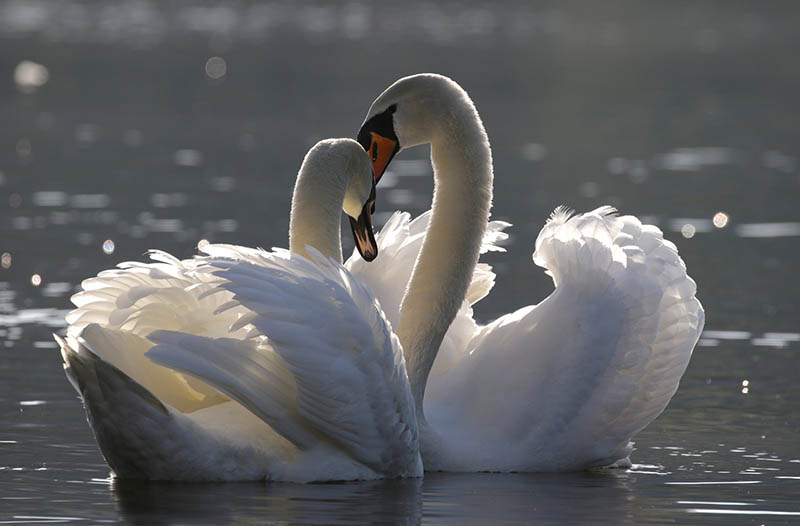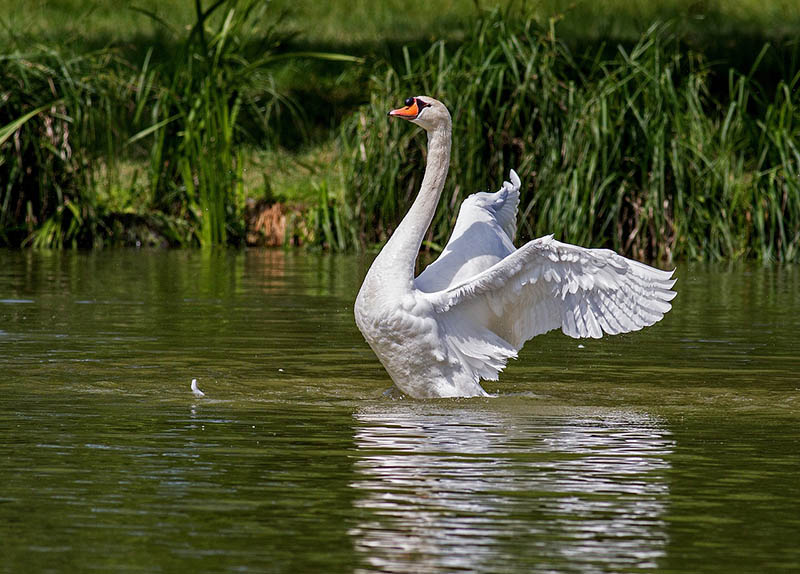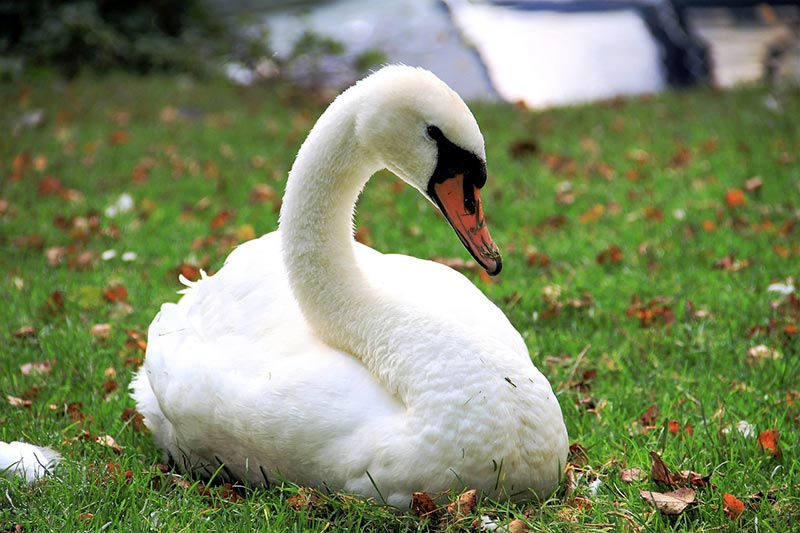Do Swans Mate For Life? Facts & FAQs
Last Updated on

For most people, swans represent grace, beauty, love, and romance. Some of you have probably heard the saying that swans mate for life, but is that belief entirely true? Are swans monogamous? Do they build life-lasting bonds?
These questions can be tricky, as the answer to these questions is neither yes nor no. Instead, it lies somewhere in the middle. Although most swans tend to form life-lasting pairs and are commonly monogamous, that’s not always the case.
Keep reading to learn more about swans and their mating habits and rituals.

How Do Swans Form Pairs?
Swans find their mates around the age of 2, although that can happen even later for some swans. It’s said swans will look for a mate who is going to be their lifelong partner. The males and females connect after their juvenile years and endure courtship behavior once they reach the breeding territory.
While courting, swans will ruffle their feathers, leaning toward one another, lifting their wings, and bowing their heads. Even when the breeding season ends, swans will stay together.
Besides showing genuine love for their mate, swan pairs help each other survive as it’s easier for them to scare away predators and find food.

Do They Mate for Life?
Do swans mate for life, and are swans monogamous? These questions still linger in the air.
Most swans are monogamous and will spend the rest of their life with one partner, and their partner bond is typically extremely strong. However, it’s not a general rule all swans follow, as swans can also separate and find new partners later in life.
Generally speaking, we can compare swan pairs with human relationships. Similarly to us, swans remain in pairs if everything is going up to their expectations. Of course, it’s not unusual for the “love” to fade and for the swans to search for a new mate.
What Can Break up a Swan Pair?
An unsuccessful breeding season is one of the most common reasons for the separation between swans. If there’s an issue with eggs not hatching, the nest getting damaged, or the swans losing cygnets, these situations could lead to a swan pair separating. If this happens, both females and males will look for new partners to prepare for the upcoming breeding season.
Another common situation when swans look for new mates is when their current mate dies. However, some swans love their partners so much that they choose to remain alone after their death. They have to go through a mourning period. Afterward, they can choose to find a new flock or remain in their current territory.
Swans can also separate for short periods and then reunite. This can happen due to internal disagreements between the pair, although they get back together if their bond is strong.

Will Swans Cheat On Their Partners?
Although swans symbolize eternal love and they typically remain with one partner for the rest of their lives, “cheating” is not uncommon for these birds. Various research shows that many swans cheat on their partner and look for sexual relationships outside their formed pair.
One out of every six swan eggs is a product of illicit encounters, showing that swans are not as innocent as they seem. This is mainly common among black swans, although it also happens to other swan species.
The females are mostly to blame for cheating as they look for males that will fertilize them, hoping that all of their eggs will result in cygnets.

Why Do Most Swans Form Lifelong Pairs?
Better Chances for Successful Nests
It’s not uncommon for swans to experience failure during the breeding and nesting season, which can be devastating at times. However, when swans are in lifelong pairs, they have enough time to learn from their mistakes and improve their chances of a successful nest.
They learn through time, leading to better nests and better care for their cygnets, resulting in a victorious clutch. Remaining in pairs also saves time as swans don’t have to look for new mates and breeding territories yearly, and that could be time-consuming.
Better Chances of Survival
Swans face various threats when in the wilderness, so forming a pair that will last for a lifetime increases their chances of survival. Although swans can defend themselves independently, a pair is much better at scaring off predators than a single swan.
Also, their future nest will be more protected when the female and the male switch in the guarding role.

How Do Swans Find a New Mate?
If swans separate, they’ll look for a new mate to start the new breeding season. The way of finding the new mate depends on the swan’s gender. The females, also known as pens, will typically look for nearby flocks they can join, where they’ll look for a new mate. That makes them more successful at finding new pairs and forming bonds.
The males, also known as cobs, are more likely to stay in their current territory, hoping to charm and seduce a passing female. As fewer lone females are passing by, this could be the reason males are less successful at finding a new mate.
Can Swans Form Pairs With Different Species?
When it comes to swan pairs, there are some deviations in which swans find pairs of different species. Some swans simply might not show interest in their species and might choose to breed with another swan species instead.
Because of those deviations, you can notice Mute swans breeding with Black or Trumpeter swans, resulting in a hybrid swan breed. Although this is uncommon, the diverse pairs have a regular bond and raise their young ones as any other swan pair would.
Another common thing that you can notice in swans is homosexual pairs. That includes both female-female and male-male pairs. Homosexual swan pairs are pretty much the same as regular pairs, although they cannot have young.
Still, pairs with two females will lay infertile eggs, but they’ll guard them as if there were cygnets inside. Similarly, males will build nests and take care of them even though there are no eggs inside. They all treat the nesting site as if it were real and have a bond like regular female-male pairs do.

Swan Breeding and Nesting Habits
Once swans form pairs, they endure courtship behavior and find their breeding territory, where they’ll build a nest. The male supplies all the needed materials, such as grass, moss, sticks, and vegetation, while the female is responsible for building the nest.
The female typically lays eggs from April to May, with the clutch containing around seven eggs. However, that number can reach up to 12 or 13 eggs per clutch. Both sexes will incubate the eggs, although it’s a bigger responsibility for the female.
The male will guard them and chase away the predators, while the female may leave for short periods to find food. If that happens, she covers the eggs until she gets back. They take between 35 and 41 days to hatch.
When cygnets hatch, the parents will provide food while simultaneously learning the cygnets to feed and swim on their own. They commonly remain with their parents until they’re old enough to fly on their own.
Once the parent swans realize their young ones are turning into juveniles, which is when their plumage changes, the male will, unfortunately, scare them off the territory. Although this may seem harsh, the swans need to prepare for a new breeding season, so the young swans need to find a new flock.
There, they’ll look for their own mates once they’re mature enough and repeat the same breeding and nesting process until they get their cygnets.

Conclusion
If you’re asking yourself, are swans monogamous, the answer is—mostly. The majority of swans form lifelong pairs, although it’s not uncommon to see separations and even unusual pairs. Needless to say, swans have a much easier life when they have a mate for life, which is why this is the most common situation in swan relationships.
Featured Image Credit: Andreas Glöckner, Pixabay
About the Author Visnja Radosavljevic
Visnja is a creative, adaptable content writer that covers various topics such as DIY, pets, home improvement, travel, gardening, and more. As a young mom and a college student, she didn’t have enough time to balance her personal and work life, so after multiple years of working a regular 9 to 5 job, she decided to pursue her passion and make a living out of it. She has been writing for a couple of years now, helping people to find valuable and interesting information online.
Related Articles:
10 Types of Hummingbirds in Arkansas (With Pictures)
8 Types of Hummingbirds in Nebraska (With Pictures)
5 Types of Hummingbirds in Idaho (With Pictures)
3 Types of Hummingbirds in Mississippi (With Pictures)
8 Types of Hummingbirds in Kansas (With Pictures)
5 Types of Hummingbirds in West Virginia (With Pictures)
5 Types of Hummingbirds in Ohio (With Pictures)
Where Do Nuthatches Nest? Nuthatch Nesting Habits Explained
